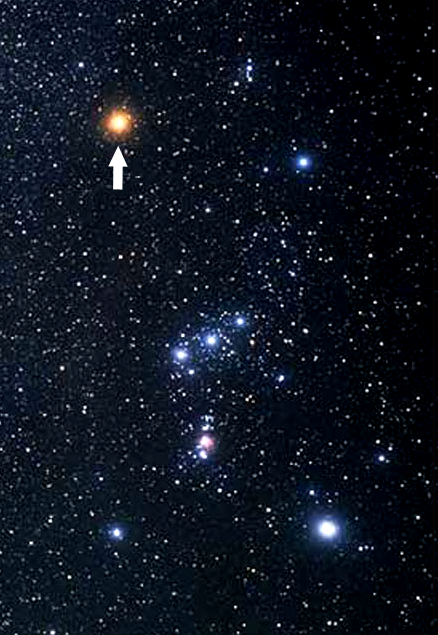Betelgeuse, Alpha Orionis, is the second brightest star in Orion constellation and the ninth brightest star in the sky. It is a supergiant star, distinctly red in colour, located at an approximate distance of 643 light years from Earth. It is an evolved star, one expected to go out as a supernova in a relatively near future.
Betelgeuse is a large, bright, massive star easily found in the sky in the winter months because it is part of a familiar pattern formed by the celestial Hunter. The red supergiant marks one of Orion‘s shoulders, while the hot, bright giant Bellatrix, Gamma Orionis, marks the other.
Betelgeuse is a variable star and, as its brightness changes, the star has been known to outshine the constellation’s brightest star, the blue supergiant Rigel, Beta Orionis.
Alpha Orionis’ traditional name, Betelgeuse, originated in the Arabic phrase Yad al-Jauzā’, meaning “the shoulder of the central one” or “the hand of Orion,” referring to the star’s position in the constellation. The phrase al-Jauzā’ is the traditional Arabic name for Orion constellation. It can be loosely translated as “the central one,” referring to a mysterious woman.
The modern Arabic name for the constellation is al-Jabbār, meaning “the giant.” With the phrase Yad al-Jauzā’, Medieval translators misread the Arabic character for Y as B, which resulted in a mistranslation into “armpit of the giant.” The name Betelgeuse can be pronounced /ˈbiːtəldʒuːs/, /ˈbiːtəldʒuːz/, or /ˈbɛtəldʒuːz/. The original pronunciation is uncertain.
Betelgeuse and Bellatrix mark the two shoulders of Orion, the Hunter. Betelgeuse, marking the right shoulder, lies in the upper left corner of the constellation from our point view. It is one of the largest and most luminous stars known. Placed at the centre of our solar system, Alpha Orionis would extend beyond the asteroid belt, all the way to the orbit of Jupiter and possibly beyond.
Betelgeuse belongs to the spectral class M2Iab. The M refers to the star’s colour, red, and the ‘Iab’ suffix indicates that the star is an intermediate luminosity supergiant. It has an absolute magnitude of roughly -6.02.
The star’s mass is uncertain, but estimates range from 7.7 to 20 times that of the Sun. As a result of its high mass, Betelgeuse has evolved quickly and, even though it is less than than 10 million years old, it is nearing the end of its life cycle. The star is believed to have an average luminosity about 120,000 times that of the Sun.
Betelgeuse is classified as a semi-regular variable star. Its apparent magnitude varies from 0.2 to 1.2 over a period of about 400 days, which is the widest magnitude range for a first magnitude star. Because it varies in magnitude, Betelgeuse occasionally surpasses Procyon in Canis Minor in brightness and becomes the seventh brightest star in the sky. When at its brightest, Betelgeuse outshines Rigel, the brightest star in Orion, and becomes the sixth brightest star in the sky. At its faintest, it drops below Deneb, the brightest star in Cygnus, and shares the position of the 20th brightest star with Mimosa, Beta Crucis, located in Crux constellation and one of the stars that form the Southern Cross.
Betelgeuse is a pulsating red supergiant showing low-amplitude variations and periods of stable brightness. The star’s pulsations result in its absolute magnitude varying from -5.27 to -6.27. As its outer layers expand and contract, the surface increases and decreases, and the temperatures rises and falls. Betelgeuse pulsates because it has an unstable stellar atmosphere. When it contracts, it absorbs more of the energy that passes through it. As a result, its atmosphere heats up and expands. When the star expands, the atmosphere becomes less dense and cools down, which leads to another period of contraction.
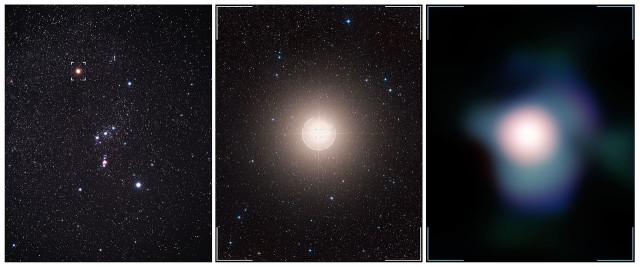
This collage shows the Orion constellation in the sky (Betelgeuse is identified by the marker), a zoom towards Betelgeuse, and the sharpest ever image of this supergiant star, which was obtained with NACO on ESO’s Very Large Telescope. Image: ESO, P.Kervella, Digitized Sky Survey 2 and A. Fujii
There are several cycles to the star’s pulsations, with short-term variations of roughly 150 to 300 days, and longer, cyclic variations over a period of about 5.7 years.
As a result of the star’s variability, limb darkening, angular diameter that tends to vary with wavelength, and the star’s tendency to occasionally change shape, many of Betelgeuse’s properties are still uncertain. Because the star is rapidly losing mass, its surface is obscured by a large envelope of ejected material, approximately 250 times larger than the star itself, which makes measurements even more difficult.
In 1985, two close companions were discovered in orbit around Betelgeuse, but have not been confirmed by research in the years since.
Betelgeuse is easy to find in the sky because it is part of a prominent winter constellation, Orion the Hunter. From mid-September to mid-March, the star is visible from almost any location on the globe, with the exception of those south of 82°S.
For observers in the northern hemisphere, Betelgeuse rises in the east just after sunset in January. In March, it is due south early in the evening. By May, the star only briefly shows up on the western horizon after sunset. In the early summer, it travels behind the Sun and can’t be seen. A few months later, it can be seen appearing on the eastern horizon just before dawn. In June and July, Betelgeuse can’t be seen at night at all, only using a telescope in daylight.
Supernova
Betelgeuse has reached a late stage of evolution and is expected to end its life in a supernova event at some point within the next million years. The red supergiant will most likely go out as a Type II supernova.
The supernova may brighten to a visual magnitude of -12 over a couple of weeks, which would make it outshine the Moon, cast shadows in the night, and be visible in daylight. The supernova would stay at that intensity for two to three months before dimming.
The last bright supernova, SN 1987A, was visible to the unaided eye even though the progenitor star wasn’t even in our galaxy, but in the nearby Large Magellanic Cloud in Dorado constellation, roughly 168,000 light years away from the solar system. While Betelgeuse is far too distant to do any damage to Earth, the supernova will certainly give us a very bright spectacle in the sky.
Earth will most likely not be affected by the event because Betelgeuse’s rotational axis is not pointed toward our planet and the gamma ray burst sent by the supernova will most likely not cause any damage to our ecosystems. Neutrinos and other forms of radiation will not reach us until 600 years after the supernova and will not affect terrestrial life. Supernovae generally must be within 25 light years to cause any significant damage to Earth. At 643 light years, Betelgeuse is more than 25 times that distance.
Betelgeuse has evolved off the main sequence and has expanded and cooled to become a red supergiant. Even though it is a relatively young star, it has likely used up the hydrogen at its core, which is causing it to contract, its temperature to rise, and its density to increase. Consequently, Betelgeuse has started fusing helium into carbon and oxygen. At some point, it will collapse and go supernova. Most likely, it will leave behind a neutron star roughly 20 kilometres in diameter.
Mass is a key factor when predicting how a star will end its life. The exact mass of Betelgeuse is uncertain, but most astronomers who have investigated the star agree that it has more than 10 solar masses. If its mass and rotation speed are sufficient, Alpha Orionis may even evolve into a yellow hypergiant or a luminous blue variable before the supernova event.
Facts
Betelgeuse is part of two familiar winter asterisms. It marks the upper right vertex of the Winter Triangle. The other two stars that form the Winter Triangle are Procyon in Canis Minor and Sirius in Canis Major. Betelgeuse also lies at the centre of the Winter Hexagon, formed by Sirius, Procyon, Pollux in Gemini, Capella in Auriga, Aldebaran in Taurus, and Rigel in Orion constellation.
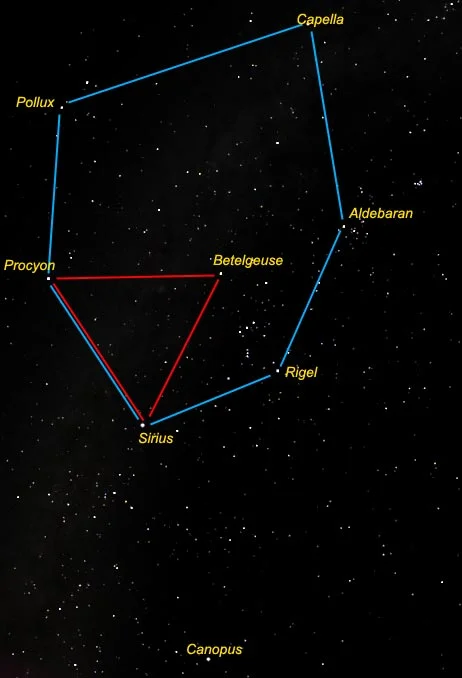
The stars of the Winter Triangle and the Winter Hexagon
In 2013, scientists said that Betelgeuse would likely crash into a “cosmic wall” of interstellar dust in several thousand years. The star’s solar wind is expected to reach the wall in about 5,000 years and the star itself is expected to crash into the bar roughly 12,500 years after that. The bar is thought to be either a linear filament linked to the Milky Way’s magnetic field or the edge of an interstellar cloud lit by Betelgeuse.
Alpha Orionis originated in the Orion OB1 Association, a group of stars whose members include the stars of Orion’s Belt, which share the same proper motion and velocity through space. The red supergiant is believed to have changed its course and motion through space at some point because its projected pathway does not seem to intersect with any star forming region. The most likely scenario is that it is a runaway member of the Orion OB1 Association, formed some 10-12 million years ago in a molecular cloud in Orion.
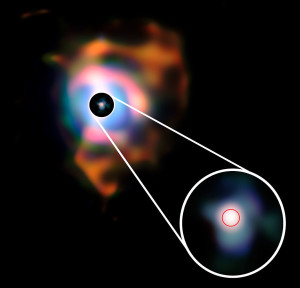
This picture of the dramatic nebula around the bright red supergiant star Betelgeuse was created from images taken with the VISIR infrared camera on ESO’s Very Large Telescope (VLT). This structure, resembling flames emanating from the star, forms because the behemoth is shedding its material into space. The earlier NACO observations of the plumes are reproduced in the central disc. The small red circle in the middle has a diameter about four and half times that of the Earth’s orbit and represents the location of Betelgeuse’s visible surface. The black disc corresponds to a very bright part of the image that was masked to allow the fainter nebula to be seen. Image: ESO, VLT, P. Kervella
Betelgeuse moves through space at a speed of 30 km/s. As a result, its stellar wind has created a bow shock more than 4 light years wide. The wind is ejecting vast amounts of gas into space at a rate of 17 km/s, heating up the material around the star. Consequently, it is visible in infrared wavelengths.
The bow shock was first imaged in 1997. Its cometary structure is believed to be at least one parsec wide if the star’s estimated distance of 643 light years from the solar system is accurate. The bow shock is estimated to be less than 30,000 years old.
Alpha Orionis is the brightest near-infrared source in the sky. It has a J band magnitude of -2.99. Only 13 percent of the star’s energy is emitted in visible light.
The star’s variability was first noted by John Herschel in 1836. He published his notes in Outlines of Astronomy. Over the next four years, Herschel noticed that Betelgeuse was showing considerable changes in magnitude. In October 1837, it outshone Rigel, the brightest star in Orion, and did it again in November 1839. The variations in brightness may have been the reason why Johann Bayer gave Betelgeuse the designation Alpha in his Uranometria, published in 1603, even though it is usually not as bright as Rigel, designated Beta Orionis.
Betelgeuse was the first star other than the Sun to have its disk imaged in optical and infrared wavelengths, by John E. Baldwin and his colleagues at the Cavendish Astrophysics Group.
Alpha Orionis is believed to have started its life as a hot, blue class O star some 10 million years ago. The star had an initial mass about 18-19 times that of the Sun.
The spelling of the name Betelgeuse did not become universal until the early 20th century. Before that, the star’s name was spelled Betelgeux or Betelgeuze.
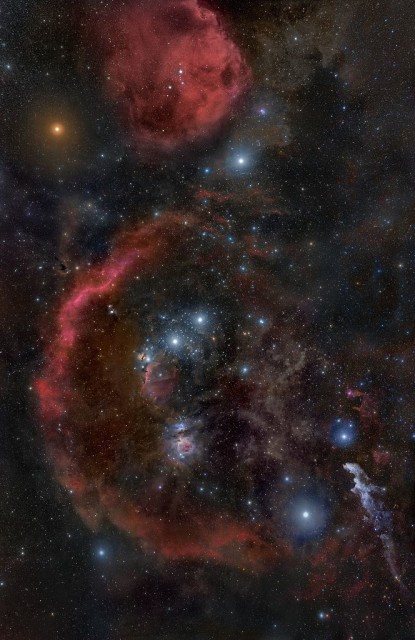
Photo taken by Rogelio Bernal Andreo in October 2010 of the Orion constellation showing the surrounding nebulas of the Orion Molecular Cloud complex. Also captured is the red supergiant Betelgeuse (top left) and the famous belt of Orion composed of the OB stars Altitak, Alnilam and Mintaka. To the bottom right can be found the star Rigel. The red crescent shape is Barnard’s Loop. The photograph appeared as the Astronomy Picture of the Day on October 23, 2010. Image: Rogelio Bernal Andreo
Betelgeuse has had many different names across the cultures, including the Sanskrit Bahu, reflecting the Hindu view of the Orion constellation as a running stag or antelope, the Persian Bašn (“the Arm”), and Coptic Klaria (“an Armlet”). The Chinese knew the star as Shēnxiùsì, the Fourth Star of the constellation of Three Stars, referring to the stars forming Orion‘s girdle. The constellation was later expanded to include ten stars. In Japan, Alpha Orionis was known as Heike-boshi, referring to the Heike clan, which adopted the star and its red colour as its symbol.
Tahitian observers considered Betelgeuse to be one of the pillars holding the sky. They knew the star as Anâ-varu. In Hawaii, the star was known as Kaulua-koko, which means “brilliant red star.”
In cultures across the Americas, the star is often seen as a severed limb. The Taulipang of Brazil called the constellation Zililkawai, and it represented a hero whose leg was severed by his wife. The star’s blinking light represented the severing of the leg. The Lakota people saw it as a chief with a severed arm.
In northern Australia, the Wardaman people called Betelgeuse Ya-jungin, meaning “Owl Eyes Flicking.” In South Africa, the star represented a lion stalking three zebras, marked by Alnilam, Alnitak, and Mintaka, the stars of Orion’s Belt.
In Macedonian legend, Betelgeuse was associated with Orach, “the ploughman,” while the rest of Orion constellation represented a plough with oxen.
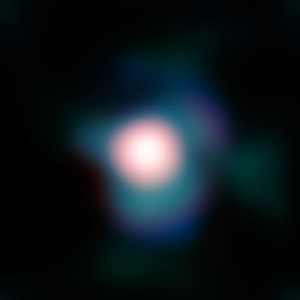
Image of the supergiant star Betelgeuse obtained with the NACO adaptive optics instrument on ESO’s Very Large Telescope. The use of NACO combined with a so-called “lucky imaging” technique, allowed the astronomers to obtain the sharpest ever image of Betelgeuse, even with Earth’s turbulent, image-distorting atmosphere in the way. The resolution is as fine as 37 milliarcseconds, which is roughly the size of a tennis ball on the International Space Station (ISS), as seen from the ground. The image is based on data obtained in the near-infrared, through different filters. The field of view is about half an arcsecond wide, North is up, East is left. Image: ESO/P. Kervella
Betelgeuse has also been mentioned in numerous films, television shows, novels, and other works of fiction. In Tim Burton’s 1988 feature Beetlejuice, a bio-exorcist played by Michael Keaton shares the star’s name. In The Hitchhiker’s Guide to the Galaxy, Betelgeuse was the home system of Zaphod Beeblebrox, the Galactic President. In The Cthulhu Mythos, the star is the home of the Elder Gods.
Betelgeuse has also been notably mentioned in Muhammad Barker’s Tékumel novels and games, Philip K. Dick’s short stories “Tony and the Beetles” (1953) and “Shell Game” (1954), Kurt Vonnegut, Jr.’s novel The Sirens of Titan (1959), Pierre Boulle’s novel Planet of the Apes (1963), Gérard Klein’s Le Gambit des Etoiles (1958), Frank Herbert’s Dune series (as Bela Tegeuse), Isaac Asimov’s The Robots of Dawn (1983), Robert J. Sawyer’s Calculating God (2000), and Jeffrey Carver’s From a Changeling Star (1989).
Betelgeuse is also mentioned in the games BattleTech, Star Control II, Frontier: Elite II, and Frontier: First Encounters.
Size
The size of Betelgeuse is difficult to determine, but its diameter is believed to change from 550 to 920 times the Sun’s diameter. The star is large enough that it reveals a disk when seen in the best telescopes.
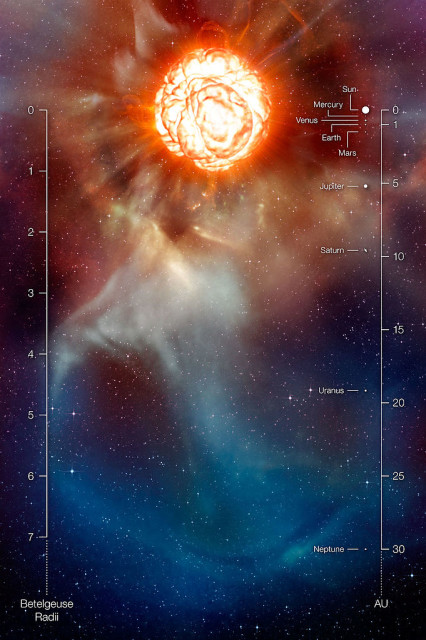
This artist’s impression shows the supergiant star Betelgeuse as it was revealed thanks to different state-of-the-art techniques on ESO’s Very Large Telescope, which allowed two independent teams of astronomers to obtain the sharpest ever views of the supergiant star Betelgeuse. They show that the star has a vast plume of gas almost as large as our Solar System and a gigantic bubble boiling on its surface. These discoveries provide important clues to help explain how these mammoths shed material at such a tremendous rate. The scale in units of the radius of Betelgeuse as well as a comparison with the Solar System is also provided. Image: ESO/L. Calçada
The star’s diameter was measured in 2000 using the Infrared Spatial Interferometer (ISI) and the calculations yielded a radius of 3.6 astronomical units.
In June 2009, Charles Townes, Nobel Laureate and inventor of the laser, announced his discovery that Betelgeuse had shrunk by 15 percent since 1993, without losing brightness. The contraction was likely a result of shell activity in Betelgeuse’s extended atmosphere. Astronomers have pinpointed at least six shells around the star. Betelgeuse was observed ejecting a vast amount of gas in July 2009, with distances roughly equalling 30 astronomical units.
Alpha Orionis was the second star after the Sun to have the angular size of its photosphere measured. It was measured on December 13, 1920 by Albert Michelson and Francis Pease at Mount Wilson Observatory. They measured the star’s angular diameter at 0.047”, which translated into a diameter of 2.58 astronomical units. However, these numbers are uncertain because of limb darkenining and measurement errors. Estimates over the years have ranged from 0.042 to 0.069 arcseconds and a projected radius of the stellar disk between 1.2 and 8.9 astronomical units.
The star’s diameter is difficult to determine for several reasons. First, because Alpha Orionis is a pulsating variable, which means that its diameter changes over time. Second, because it is difficult to determine a definable ‘edge’ of the star because limb darkening causes its optical emissions to vary in colour. Third, because it is also hard to define the star’s photosphere because it is surrounded by a a thick gaseous envelope made up of material ejected by the star which absorbs and emits light. As a result, the measured diameter changes depending on the wavelength used to measure it.
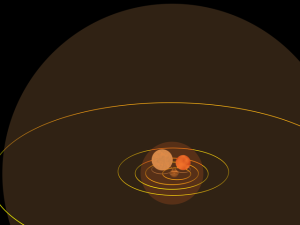
Comparison of size of Betelgeuse (largest dull-red sphere inside Jupiter’s orbit) and R Doradus (red sphere shown inside Earth’s orbit) together with the orbits of Mars, Venus and Mercury and the stars Rigel and Aldebaran from Image:1e10m comparison Rigel, Aldebaran, and smaller – antialiased no transparency.png, to scale. The faint yellow sphere centred on the Sun has a radius of one light-minute. The yellow ellipses represent the orbits of each planet. Image: Paul Stansifer and 84user at wikipedia.org
Betelgeuse was once thought to have the largest angular diameter of any star. However, after a team of astronomers measured the diameter of R Doradus at 57.0 mas. in 1997, the star lost this distinction. It is now considered to be in third place even though R Doradus, a Mira variable located in Dorado constellation and much closer to Earth at less than 200 light years, has a diameter only about a third that of Alpha Orionis.
Betelgeuse’s estimated radius is about 5.5 astronomical units, which makes the star around 1,180 times larger than the Sun. With the observed contraction, the star’s radius has shortened to 4.6 astronomical units.
Distance
Betelgeuse lies at a distance of 643 light years or 197 parsecs from Earth. Earlier estimates of the star’s distance were 430 light years (131 parsecs) in 1997, and 520 light years (152 parsecs) in 2007.
The star’s exact distance is uncertain because direct parallax measurement results in a distance of about 495 light years, while the parallax using the natural radio emission yields about 640 light years. Sometimes the middle distance – 570 light years – is cited.
In 2008, Graham Harper and colleagues used the Very Large Array (VLA) and came up with radio data that yielded a distance of 643 light years.
Colour
Alpha Orionis has a colour index (B–V) of 1.85, which makes it a very red star.
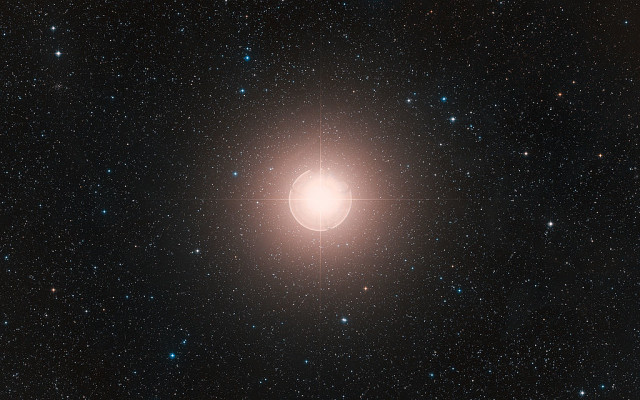
This image is a colour composite made from exposures from the Digitized Sky Survey 2 (DSS 2). The field of view is approximately 2.0 x 1.5 degrees. Image: ESO/Digitized Sky Survey 2
The star’s photosphere has an extended atmosphere. As a result of being surrounded by a thick envelope of gas, the star’s extended atmosphere exhibits strong lines of emission rather than absorption. It has been known to move away and toward the star as a result of radial velocity fluctuations in the photosphere.
The star’s red colour has been documented since antiquity. The Greek astronomer Ptolemy described it as ruddy (ὑπόκιρρος – hypókirros) in the 2nd century. Three centuries before Ptolemy’s observations, Chinese astronomers noted that the star had a yellow coloration. This indicates that Betelgeuse may have been a yellow supergiant just before the beginning of the common era.
Temperature
The temperature of the star’s surface is estimated to be between 3,140 and 3,641 K. The estimated temperature of the star’s atmosphere is around 3,450 K. The gas around the star gradually cools as it expands away from the star.
Betelgeuse – Alpha Orionis
Constellation: Orion
Coordinates: 05h 55m 10.3053s (right ascension), +07°24’25.426” (declination)
Spectral class: M2Iab
Apparent magnitude (visible spectrum): 0.42 (0.3 to 1.2)
Apparent magnitude: (J band): -2.99 ± 0.10
Absolute magnitude: -6.02
Distance: 643 ± 146 light years (197 ± 45 parsecs)
Variable type: SR c (semi-regular variable)
Mass: 7.7 – 20 solar masses
Radius: 950 – 1,200 solar radii
Luminosity: 120,000 ± 30,000 solar luminosities
Temperature: 3,140 – 3,641 K
Rotation: 5 km/s
Age: 7.3 million years
Pronunciation: /ˈbiːtəldʒuːs/, /ˈbiːtəldʒuːz/, or /ˈbɛtəldʒuːz/
Designations: Betelgeuse, Alpha Orionis, α Orionis, 58 Orionis, HR 2061, BD +7° 1055, HD 39801, FK5 224, HIP 27989, SAO 113271, GC 7451, CCDM J05552+0724AP, AAVSO 0549+07
